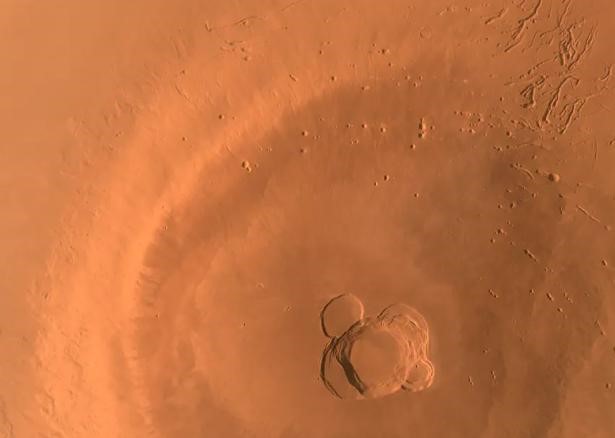After exploring Mars for more than a year, China’s Tianwen-1 space probe has successfully taken images covering the entire Red Planet, China’s National Space Administration (CNSA) announced on June 29. Tianwen-1, which translates to “quest for heavenly truth”, consists of six separate spacecraft: an orbiter, two deployable cameras, lander, remote camera, and Zhurong rover. The images in question were taken by the orbiter while circling Mars 1,344 times, capturing images of the Red Planet from every angle while Zhurong explored the surface.
in the statement, CNSA said the probe has now completed all of its tasks, which included taking medium-resolution images covering the entire planet. Tianwen-1 was launched on July 23, 2020, amidst the turmoil of the Covid-19 global pandemic. What’s unique about this mission is China was attempting to become the first nation to successfully send an orbiter and rover to Mars on the first try.
Upon successful orbital insertion and landing, Tianwen-1 became a historic victory for both the CNSA and space exploration. Before Tianwen-1, the only two successful missions to send both an orbiter and lander to Mars were NASA’s Viking 1 and 2 missions in 1975. Prior to that, the Soviet Union had attempted this feat with their Mars 2 and 3 missions in 1971, and Mars 6 in 1973.
Mars 2 was an outright failure with the lander being destroyed and the orbiter sending back no data. On Mars 3, the orbiter obtained approximately eight months of data and while the lander touched down safely, it only returned 20 seconds of data. On Mars 6, the orbiter produced data from an occultation experiment, but the lander failed on descent.
During its time exploring the Red Planet, Tianwen-1 showed a Mars we’ve come to both love and admire: dusty dunes, shield volcanoes, impact craters, and even the north pole. While the orbiter was taking these amazing images, Zhurong was gathering data and information about Mars’ geological structure, atmosphere, environment, and soil. Overall, the probe has collected 1,040 gigabytes of raw scientific data, which the CNSA said has been processed by scientists back on Earth and handed over to researchers for further study.
An image of dunes on Mars, taken by the Zhurong rover of the Tianwen-1 probe shortly before it entered dormancy in May 2022. (Credit: CNSA) An image of a mountain on Mars taken by China’s Tianwen-1 probe. (Credit: CNSA) Black-and-white picture of Mars taken by Tianwen 1.
(Credit: CNSA) North pole of Mars. (Credit: CNSA) While the probe entered Mars’ orbit on February 10, 2021, the Zhurong rover didn’t touch down on Mars until May 14 of that same year. It landed in Utopia Planitia, current home of NASA’s Viking 2 spacecraft which landed in the vast Martian plain in 1975.
In June 2022, Zhurong successfully found hydrated minerals in sediment dating to Mars’ most recent geologic period which are likely associated with groundwater. Hydrated minerals include substances such as olivine, pyroxene, and feldspar that were likely altered as they integrated water into their chemical structures. Unfortunately, Zhurong had to enter its dormant mode starting on May 18, 2022, due to dropping temperatures during the Martian winter, along with poor sand and dust conditions.
This dormant mode ensures the long-term survivability of the rover, which will reawaken sometime in December. While Tianwen-1 makes China only the third nation to successfully land a spacecraft on the surface of Mars, the European Space Agency (ESA), India, and the United Arab Emirates have successfully sent their respective spacecraft to orbit the Red Planet. Tianwen-1 also demonstrates China’s strong aspiration to explore Mars, as it recently announced plans to return Mars samples to Earth in 2031, a full two years earlier than NASA and the ESA.
Along with their ambitious robotic missions, the CNSA announced last year that they plan to send its first crewed mission to the Red Planet in 2033 with goal to send regular missions to Mars and eventually build a base there. This 2033 timeframe is in stark contrast to NASA, who announced earlier this year that they plan to launch astronauts to Mars in the late 2030s or early 2040s. China seems very serious about human space exploration, as their Tiangong space station currently houses three astronauts on six-months stays, with the most recent crew arriving just last month.
Where will space exploration take us in the coming years? Which country will land the first humans on Mars? Only time will tell, and this is why we science! Sources: CNN, The Planetary Society, NASA, Eos, Space. com, CNBC, Space. com (2) As always, keep doing science & keep looking up! The post China’s Tianwen-1 has Imaged the Entire Surface of Mars, Completing its Primary Mission appeared first on Universe Today.
.
From: universetoday
URL: https://www.universetoday.com/156680/chinas-tianwen-1-has-imaged-the-entire-surface-of-mars-completing-its-primary-mission/



